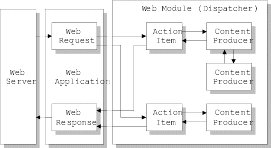The Structure of a Web Broker Application
Go Up to Using Web Broker Index
When the Web application receives an HTTP request message, it creates a Web.HTTPApp.TWebRequest object to represent the HTTP request message, and a Web.HTTPApp.TWebResponse object to represent the response that should be returned. The application then passes these objects to the Web dispatcher (either the Web module or a TWebDispatcher component).
The Web Dispatcher controls the flow of the Web server application. The dispatcher maintains a collection of action items (TWebActionItem) that know how to handle certain types of HTTP request messages. The dispatcher identifies the appropriate action items or auto-dispatching components to handle the HTTP request message, and passes the request and response objects to the identified handler so that it can perform any requested actions or formulate a response message.
The action items are responsible for reading the request and assembling a response message. Specialized content producer components aid the action items in dynamically generating the content of response messages, which can include custom HTML code or other MIME content. The content producers can make use of other content producers or descendants of THTMLTagAttributes, to help them create the content of the response message.
If you are creating a server that implements a Web Service, your Web server application may include an auto-dispatching component that passes SOAP-based messages on to an invoker that interprets and executes them. The dispatcher calls on these auto-dispatching components to handle the request message after it has tried all of its action items.
When all action items (or auto-dispatching components) have finished creating the response by filling out the TWebResponse object, the dispatcher passes the result back to the Web application. The application sends the response on to the client via the Web server.
